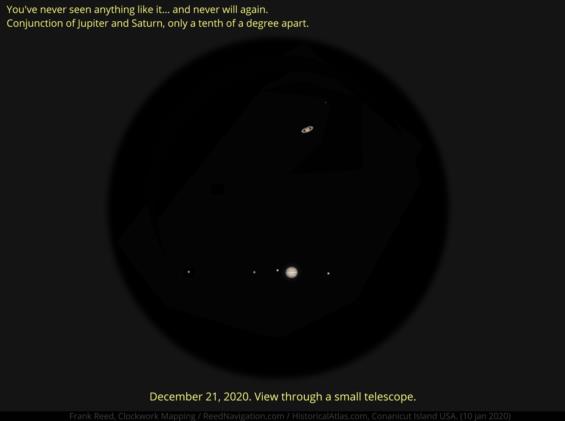
NavList:
A Community Devoted to the Preservation and Practice of Celestial Navigation and Other Methods of Traditional Wayfinding
From: Frank Reed
Date: 2020 Dec 20, 10:35 -0800
Regarding the math on this, if you want to calculate the angular separation between Jupiter and Saturn, you have a few options. It's an interesting case because the angular separation is so small.
Option 1: The long way, but not so long when you have some coding or spreadsheet skills. Just use the standard great circle distance equation:
D = acos[ sin(Dec1) · sin(Dec2) + cos(Dec1) · cos(Dec2) · cos(dHA) ]
where D is the angular distance we're looking for, and dHA is the difference in HA where "HA" can be any variant on a "longitude" perpendicular to declination: RA or SHA or GHA or LHA or HA --any will work.
Option 2: Also a long way but with some flexibility. Use the standard great circle distance with coordinates of altitude (H) and azimuth (Z):
D = acos[ sin(H1) · sin(H2) + cos(H1) · cos(H2) · cos(dZ) ].
I mention this option becaue you can run with either the refracted altitudes or the true altitudes. Of course the distance you measure with your sextant will most closely match the distance calculated with the refracted altitudes. But since the bodies are nearly at the same altitude, does it matter?
Option 3: If we "zoom in" on the geometry, we can project a small region of the sky onto a flat plane, exactly like using a small scale plotting chart or UPS. In this case we can calculate the difference in a "y" coordinate which is just difference in declination and an "x" coordinate which is difference in HA scaled by dec:
xi = Deci,
yi = HAi · cos(Dec),
and then distance is given by the usual Pythagorean sum of the squares of the differences in the coordinates:
D2 = (x1 - x2)2 + (y1 - y2)2.
Option 4: Same as option 4 with altitudes and azimuths. Like option 2, this has the advantage that we can easily run the math for refracted and unrefracted cases. Also, if you like the math here, there are simplifications that come into play when you look at differential refraction for objects separated by less than a degree (or two side of an object, like the Sun or Moon, with an angular diameter smaller than a degree).
The Pythagorean approach of Options 3/4 used to be considered a good simplification in cases like this where the angles are small. But suppose you work these up on a calculator... Is there really any advantage? Try counting keystrokes. There's not much difference. One remaining advantage of Options 3/4 is that they have nice, transparent interpretations. By contrast, picturing an exceedingly skinny spherical triangle can be a little mystifying. The math yields nearly the same result either way, and it's worth seeing that.
Frank Reed







